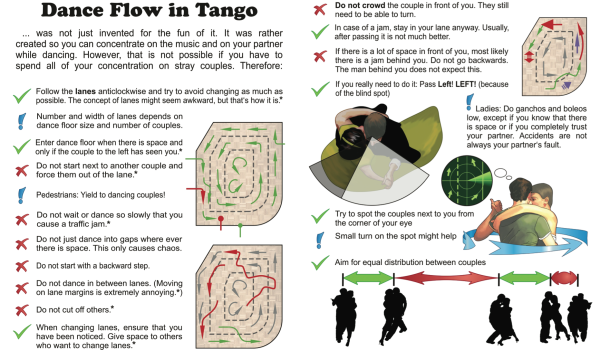Understanding the Line of Dance
It is a very typical tango practice to have large numbers of people dancing together in small spaces. This is only possible because a set of dance floor rules exist to allow dancers to coexist safely and happily. Here are the basics of the “Line of Dance.”
Each couple progresses counter-clockwise around the room, in a given lane. The number of lanes depends on the size/shape of the room. The width of each lane is about 3.5 feet.
Each lane travels all the way around the room, with the outer lane being longest. Inner lanes are nested inside the outer lane, with each traveling a progressively shorter path around the room. We are working on adding a great graphic for this!
Once dancing a song, it is not ok to:
- Pass another couple
- Changes lanes
- Hold up traffic (if something happens, and you need to stop dancing, you and your partner should make your way off the dance floor)
The easiest lane to conceptualize and dance in is the outer lane. Less experienced dancers should stick to the outside lane.
Make sure you dance deep into each corner. If you cut corners, you make the dance floor smaller for everyone, and also risk moving through an inner lane that doesn’t belong to you.
When entering a dance floor in which people are already dancing, the entering leader should attempt to make eye contact with the leader that is coming up on their left. The leader already dancing should give a nod to show that they see the new couple and are leaving space for them to start dancing in front of them.
Recognize that the leader in the oncoming couple may be of any gender. Please don’t assume that the leader is always a man.
It takes practice to learn how to keep up with the couple in front of you, without getting too close, and to be aware of the couples behind you and next to you. A good leader needs both walking sequences that progress, and steps that stay in place, in order to navigate the dance floor. These can be acquired in just a few lessons, but can be refined for decades. Try to view the learning process as a fun challenge, and an endless opportunity to keep learning and experimenting.
It’s important to know what is going on behind you and next to you. Use simple turns or other movements that “change front” to get updated data on the dancers behind and next to you. While one small back step is usually possible, that is not always the case. Generally it is NOT ok to take more than one small back step against the line of dance.
Followers should not assume that the leader is doing all the work! Do your part to help stay in your lane, for example, by progressing slightly to your left in the walk to the cross (which helps you stay in your lane), instead of to your right (which moves you into an inner lane).
Before doing any large movements (especially boleos, ganchos and other movements that involve lifting the leg from the ground), the follower should check that there is space. The leader may not have realized that the movement was unsafe, or someone may have occupied the space in the second after the lead was given.
It is common in Argentina for dancers to chat between song and song. In Buenos Aires, the chatting can go on for a while. Here in the United States, we chat less in between songs. Be aware of when the people around you take an embrace and start dancing. Do not keep chatting when those around you are already dancing.
It is typical to dance to the end of the “tanda” (set). If you can’t for any reason, that’s ok. Let your partner know and move carefully off the dance floor.
Please let us know if we’ve missed something!
© 2022 Philadelphia Argentine Tango School
We are working on our own graphic, but until then, please reference this one. Thanks to Dirk Apitz!
2030 Frankford Avenue
Philadelphia, PA 19125
617-291-3798
[email protected]
